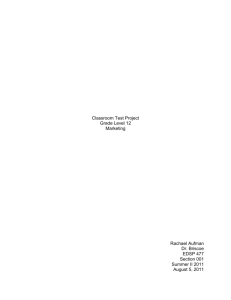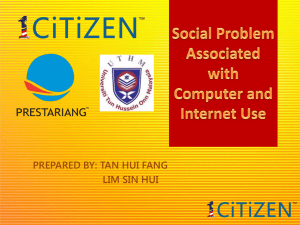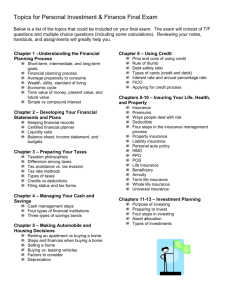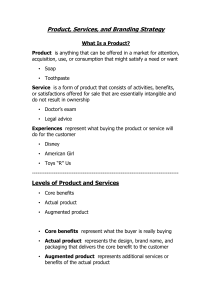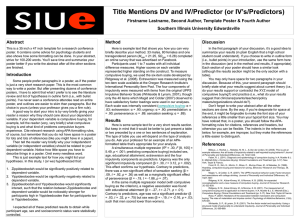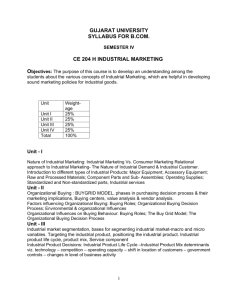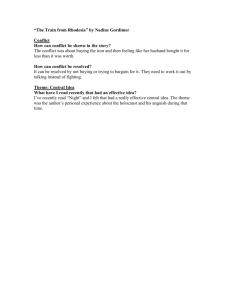Burcu Cokgezen Julie Doxsee Comm 102 Section 21 First Polished
advertisement
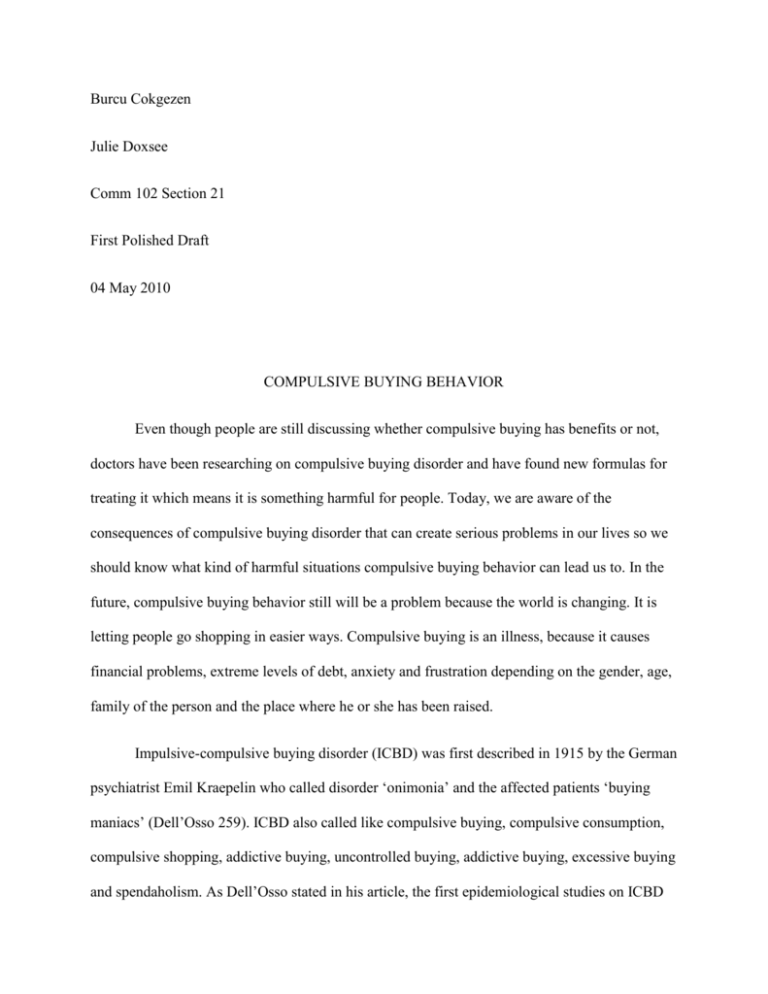
Burcu Cokgezen Julie Doxsee Comm 102 Section 21 First Polished Draft 04 May 2010 COMPULSIVE BUYING BEHAVIOR Even though people are still discussing whether compulsive buying has benefits or not, doctors have been researching on compulsive buying disorder and have found new formulas for treating it which means it is something harmful for people. Today, we are aware of the consequences of compulsive buying disorder that can create serious problems in our lives so we should know what kind of harmful situations compulsive buying behavior can lead us to. In the future, compulsive buying behavior still will be a problem because the world is changing. It is letting people go shopping in easier ways. Compulsive buying is an illness, because it causes financial problems, extreme levels of debt, anxiety and frustration depending on the gender, age, family of the person and the place where he or she has been raised. Impulsive-compulsive buying disorder (ICBD) was first described in 1915 by the German psychiatrist Emil Kraepelin who called disorder ‘onimonia’ and the affected patients ‘buying maniacs’ (Dell’Osso 259). ICBD also called like compulsive buying, compulsive consumption, compulsive shopping, addictive buying, uncontrolled buying, addictive buying, excessive buying and spendaholism. As Dell’Osso stated in his article, the first epidemiological studies on ICBD date from the last decade (260). There are hundreds of clinical researches for the measurement of this illness which continued after Kraepelin’s description of onimonia. Since its description ‘onimonia (buying mania)’, the biggest experimental developments took part in history in 1990’s. In addition to Dell’Osso’s article, Black asserts that Kraepelin and Bleuler both classified compulsive buying as one of the impulsive insanities alongside kleptomania and pyromania in 1915 (18). In Canada in 1985, Valence et al. developed the C.B.S. (Compulsive Buying Scale) in 1985 (Black 18). As Black explained in his article, Glatt et al. have suggested in 1987 that compulsive buying is similar, in many respects, to alcohol and drug addiction (18). A modified version of the C.B.S. was tested by German researchers in 1990. Consumer behavior researchers, Faber and O’Guinn, used the C.B.S. to investigate the prevalence of compulsive buying in the USA in 1992. In 1994, Christenson et al. have developed the Minnesota Impulsive Disorder Interview which is used to assess the presence of compulsive buying (18). Also, Dell’Osso et al. states that dopamine has been theorized to play a role in behavioral addictions in 2001 (262). According to the measurement methods that all these researchers found, we see that compulsive buying is an addicting buying disorder which created such bad consequences in the history: It is addicting, giving people artificial happiness, and letting them feel good for a short period of time. Day by day, technology is developing and as Dell’Osso et al. asserted in the article, the easy availability of credit cards, increased and more affective advertising, the possibility of buying through home shopping TV shows and the Internet, as well as the destruction of family structure and a breakdown in the sense community have been indicated as factors contributing to the onset of ICBD (260). Compulsive buying can lead us to harmful situations, because, today, consequences of compulsive buying can create serious problems in our lives. People who are shopping compulsively show compulsivity as a personal trait, lower self-esteem and they become more prone to fantasies than normal consumers. Some people think that compulsive buying is making them feel better and less stressful while others are saying that it is an illness and addicted people need to be sent to the doctors. Doctors perceive compulsive buying disorder as an issue and they explain that compulsive buying include extreme levels of debt, anxiety, frustration, the subjective sense of loss of control, and domestic dimensions (O’Guinn et al. 147). If people can be acknowledged about compulsive buying disorder’s consequences, they can stop themselves with appropriate treating methods in clinics of professional psychiatrists. Compulsive buying is a very current topic and so many people are facing with its simpler forms or the higher levels. Compulsions are “repetitive and seemingly purposeful behaviors that are performed according to certain rules or in a stereotyped fashion” as it is described in American Psychiatric Association defined in 1985. Compulsive buying is a worldwide problem that is increasing day by day. The world is changing technologically, so people are having various options to do shopping more easily, for instance, by doing online shopping. Also, as it is explained in the article written by O’Guinn et al, compulsive buying is a chronic, repetitive purchasing behavior that is a primary response to the negative events or feelings (147). People who are dealing with the compulsive buying disorder go shopping especially when they feel stressful. In the article, it is demonstrated by the authors that compulsive buying behavior provides short term relief according to the results of the experiments which made on the patients who had compulsive buying disorders (148). When the compulsive buyers are in a bad mood, they feel like they should go shopping and feel relaxed. This situation creates the addiction because the relief they get after shopping does not stay long. Impulsively buying is also conceptualized as a desire for specific items by the impulsive buyers that many of them do not have a great deal of interest in items after they are purchased (150). Compulsive buyers do not buy goods just because they need them. They can buy everything without needing them. Even though the modern experiments show that compulsive buying is an illness which should be treated, people are still having trouble to realize it and go to the doctors. This situation cause lowered self-esteem, remorseful feelings and a deleterious impact on interpersonal relationships (O’Guinn et al. 150). When compulsive buyers have less interpersonal relationships, they get more and more alone and do more shopping which take them to loneliness. Today, as O’Guinn et al. explained, compulsive buyers have more bank credit cards and develop feelings of shame and guilt associated with their behavior. Feelings of alienation, legal problems, and marital difficulties were mentioned as consequences of compulsive buying. They have the feeling of frustration and of not being able to control one’s own behavior (155). In addition to information above, the authors Ridgway, Kinney and Monroe points out in their article that we should know the compulsive buying as a lack of impulse control over buying (622). Compulsive buying creates harmful situations, even today, by ignoring all the new experiments and treating methods as a strong matter. Compulsive buying is a crucial subject for the future. This issue is significant because its consequences might affect our lives in a bad way. It can construct psychological and mental problems as well as it creates financial difficulties for our social lives. If the compulsive buying behavior is known well and a person has an opinion about what possible dangerous results he or she might reach after, it will be taken more seriously by the person. As Dittmar explained in her article, it is an understudied, but growing, dysfunctional consumer behavior with harmful psychological and financial consequences (467). Also, because of our gender, age and family that might help the creation of compulsive buying disorder, it will always be an enduring issue. Gender, age and the family has a big impact on the development of this harmful and repetitive compulsive buying behavior. The creation of financial problems, lower self esteem, and extreme levels of debt, anxiety and frustration are directly related to the gender, age and the family of the person. In her article, Dittmar makes a questionnaire and reaches the result that there is a big difference between genders and different age groups for compulsive buying. The results of the tests show that younger people are more prone to compulsive buying; women are highly vulnerable to compulsive buying, although gender differences may be less pronounced in younger samples and emotional and identity-related dimensions of shopping are more important for women than for men (Dittmar 470). The effects of genetics and the environment on compulsive buying behavior are discussed in the article written by Gwin, Roberts and Itesm. The authors assert in the article that even though so many factors have been studied for describing the compulsive buying disorder, the effect of the family and the environment has never been emphasized strongly(95). It is crucial to find out the families’ roles on compulsive buying disorder. Several studies support the potential importance of genetics in compulsive buying behavior based on family history (Gwin et al. 96). The authors of the article made two hypotheses to find out the importance of the nature and the nurture on compulsive buying. First, they said that genetic predispositions (nature) toward compulsive buying will increase the likelihood of compulsive buying (96). Then they asserted that the family environment (nurture) will impact the likelihood of compulsive buying (98). The results of the experiments showed that both hypotheses were true which meant nature & nurture had an impact on the development of compulsive buying disorder. The important events that might affect a person psychologically are also important for the creation of compulsive buying. For instance, it is found by the experiments that the divorce had a significant impact on the likelihood of compulsive buying behavior (Gwin et al. 97) Rindfleisch et al. found higher levels of compulsive buying in young adults from disrupted families than intact families in 1997 (Gwin et al. 97). As the results of all the information given above, we should know that compulsive buying is an issue that will always affect our lives with its harmful consequences and to find out the problem which is causing this illness, we should always consider about the gender, age and the nature & nurture of the people. Works Cited Black, Donald W. “Compulsive Buying Disorder: Definition, Assessment, Epidemiology and Clinical Management” CNS Drugs 2001, Vol. 15 Issue 1, p17-27. Dell’Osso, Bernardo, et al. “Impulsive-Compulsive Buying Disorder: Clinical Overview” Australian and New Zealand Journal of Psychiatry 2008: 42:259-266. Dittmar, Helga. “Compulsive Buying – A Growing Concern? An Examination of Gender, Age, and Endorsement of Materialistic Values as Predictors” British Journal of Psychology: November 2005, Vol. 96 Issue 4, p467-491. Gwin, Carol F, et al. “Nature vs. Nurture: The Role of Family in Compulsive Buying.” Marketing Management Journal: Spring 2005, Vol. 15 Issue 1, 95-107. O’Guinn, Thomas C, et al. “Compulsive Buying: A Phenomenological Exploration” Journal of Consumer Research: Sep 1989, Vol. 16 Issue 2, 147-157. Ridgway, Nancy M, et al. “An Expanded Conceptualization and a New Measure of Compulsive Buying” Journal of Consumer Research: December 2008, Vol. 35 Issue 4, 622-639.
